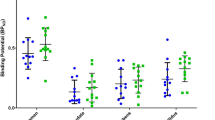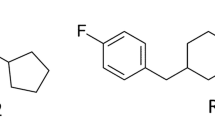Abstract
Purpose
The aim of this study was to evaluate the suitability of [11C]SCH442416 for the in vivo imaging of adenosine A2A receptors.
Methods
In rats and Macaca nemestrina, we evaluated the time course of the cerebral distribution of [11C]SCH442416. Furthermore, in rats we investigated the rate of metabolic degradation, the inhibitory effects of different drugs acting on adenosine or dopamine receptors and the modification induced by the intrastriatal administration of quinolinic acid (QA).
Results
The rate of metabolic degradation of [11C]SCH442416 in rats was slow; 60 min after tracer injection, more than 40% of total plasma activity was due to unmetabolised [11C]SCH442416. At the time of maximum uptake, radioactive metabolites represented only 6% of total extractable activity in the cerebellum and less than 1% in the striatum. In the striatum, the region with the highest expression of A2A receptors, the in vivo uptake of [11C]SCH442416 was significantly reduced only by drugs acting on A2A receptors or by QA, a neurotoxin that selectively reduces the number of intrastriatal GABAergic neurons. Position emission tomography (PET) studies in monkeys indicated that the tracer rapidly accumulates in brain, reaching maximum uptake between 5 and 10 min. Twenty minutes after the injection, radioactivity concentration in the striatum was two times that in the cerebellum.
Conclusion
The specificity of binding, the rank order of regional distribution in the brain of rats and M. nemestrina, the good signal to noise ratios and the low amount of radioactive metabolites in brain and periphery indicate that [11C]SCH442416 is a promising tracer for the in vivo imaging of A2A adenosine receptors using PET.




Similar content being viewed by others
References
Latini S, Pedata F. Adenosine in the central nervous system: release mechanisms and extracellular concentrations. J Neurochem 2001;79(3):463–84.
Dunwiddie TV, Masino SA. The role and regulation of adenosine in the central nervous system. Annu Rev Neurosci 2001;24:31–55.
Fredholm BB, Arslan G, Halldner L, Kull B, Schulte G, Wasserman W. Structure and function of adenosine receptors and their genes. Naunyn Schmiedebergs Arch Pharmacol 2000;362(4–5):364–74.
Ongini E, Fredholm BB. Pharmacology of adenosine A2A receptors. Trends Pharmacol Sci 1996;17(10):364–72.
Cunha RA, Johansson B, van der Ploeg I, Sebastiao AM, Ribeiro JA, Fredholm BB. Evidence for functionally important adenosine A2a receptors in the rat hippocampus. Brain Res 1994;649(1–2):208–16.
Svenningsson P, Le Moine C, Fisone G, Fredholm BB. Distribution, biochemistry and function of striatal adenosine A2A receptors. Prog Neurobiol 1999;59(4):355–96.
Ferre S, Fredholm BB, Morelli M, Popoli P, Fuxe K. Adenosine-dopamine receptor–receptor interactions as an integrative mechanism in the basal ganglia. Trends Neurosci 1997;20(10):482–7.
Fuxe K, Stromberg I, Popoli P, Rimondini-Giorgini R, Torvinen M, Ogren SO, et al. Adenosine receptors and Parkinson’s disease. Relevance of antagonistic adenosine and dopamine receptor interactions in the striatum. Adv Neurol 2001;86:345–53.
Ikeda K, Kurokawa M, Aoyama S, Kuwana Y. Neuroprotection by adenosine A2A receptor blockade in experimental models of Parkinson’s disease. J Neurochem 2002;80(2):262–70.
Abbracchio MP, Cattabeni F. Brain adenosine receptors as targets for therapeutic intervention in neurodegenerative diseases. Ann N Y Acad Sci 1999;890:79–92.
Ledent C, Vaugeois JM, Schiffmann SN, Pedrazzini T, El Yacoubi M, Vanderhaeghen JJ, et al. Aggressiveness, hypoalgesia and high blood pressure in mice lacking the adenosine A2a receptor. Nature 1997;388(6643):674–8.
El Yacoubi M, Ledent C, Parmentier M, Bertorelli R, Ongini E, Costentin J, et al. Adenosine A2A receptor antagonists are potential antidepressants: evidence based on pharmacology and A2A receptor knockout mice. Br J Pharmacol 2001;134(1):68–77.
Moresco RM, Messa C, Lucignani G, Rizzo GG, Todde S, Carla Gilardi M, et al. PET in psychopharmacology. Pharmacol Res 2001;44(3):151–9.
Ishiwata K, Noguchi J, Wakabayashi S, Shimada J, Ogi N, Nariai T, et al. 11C-labeled KF18446: a potential central nervous system adenosine A2a receptor ligand. J Nucl Med 2000;41(2):345–54.
Todde S, Moresco RM, Simonelli P, Baraldi PG, Cacciari B, Spalluto G, et al. Design, radiosynthesis, and biodistribution of a new potent and selective ligand for in vivo imaging of the adenosine A(2A) receptor system using positron emission tomography. J Med Chem 2000;43(23):4359–62.
Levivier M, Holemans S, Togasaki DM, Maloteaux JM, Brotchi J, Przedborski S. Quantitative assessment of quinolinic acid-induced striatal toxicity in rats using radioligand binding assays. Neurol Res 1994;16(3):194–200.
Levivier M, Przedborski S. Quinolinic acid-induced lesions of the rat striatum: quantitative autoradiographic binding assessment. Neurol Res 1998;20(1):46–56.
Belloli S, Moresco RM, Matarrese M, Biella G, Sanvito F, Simonelli P, et al. Evaluation of three quinoline-carboxamide derivatives as potential radioligands for the in vivo PET imaging of neurodegeneration. Neurochem Int 2004;44(6):433–40.
Paxinos G, Watson C. The rat brain in stereotaxic coordinates, 4th edn. New York: Academic Press; 1998.
Lammertsma AA, Hume SP. Simplified reference tissue model for PET receptor studies. Neuroimage 1996;4(3 Pt 1):153–8.
Gunn RN, Lammertsma AA, Hume SP, Cunningham VJ. Parametric imaging of ligand-receptor binding in PET using a simplified reference region model. Neuroimage 1997;6(4):279–87.
Press WH, Flannery BP, Teukolsky SA, Vetterling WT. Numerical recipes. The art of scientific computing. New York, Cambridge: Cambridge University Press; 1986.
Ishiwata K, Ogi N, Hayakawa N, Oda K, Nagaoka T, Toyama H, et al. Adenosine A2A receptor imaging with [11C]KF18446 PET in the rat brain after quinolinic acid lesion: comparison with the dopamine receptor imaging. Ann Nucl Med 2002;16(7):467–75.
El Yacoubi M, Ledent C, Parmentier M, Ongini E, Costentin J, Vaugeois JM. In vivo labelling of the adenosine A2A receptor in mouse brain using the selective antagonist [3H]SCH 58261. Eur J Neurosci 2001;14(9):1567–70.
Noguchi J, Ishiwata K, Wakabayashi S, Nariai T, Shumiya S, Ishii S, et al. Evaluation of carbon-11-labeled KF17837: a potential CNS adenosine A2a receptor ligand. J Nucl Med 1998;39(3):498–503.
Wang WF, Ishiwata K, Nonaka H, Ishii S, Kiyosawa M, Shimada J, et al. Carbon-11-labeled KF21213: a highly selective ligand for mapping CNS adenosine A(2A) receptors with positron emission tomography. Nucl Med Biol 2000;27(6):541–6.
Acknowledgements
Part of the project has been supported by the Italian Ministry of Health (Ricerca Finalizzata 2000).
Author information
Authors and Affiliations
Corresponding author
Rights and permissions
About this article
Cite this article
Moresco, R.M., Todde, S., Belloli, S. et al. In vivo imaging of adenosine A2A receptors in rat and primate brain using [11C]SCH442416. Eur J Nucl Med Mol Imaging 32, 405–413 (2005). https://doi.org/10.1007/s00259-004-1688-5
Received:
Accepted:
Published:
Issue Date:
DOI: https://doi.org/10.1007/s00259-004-1688-5




